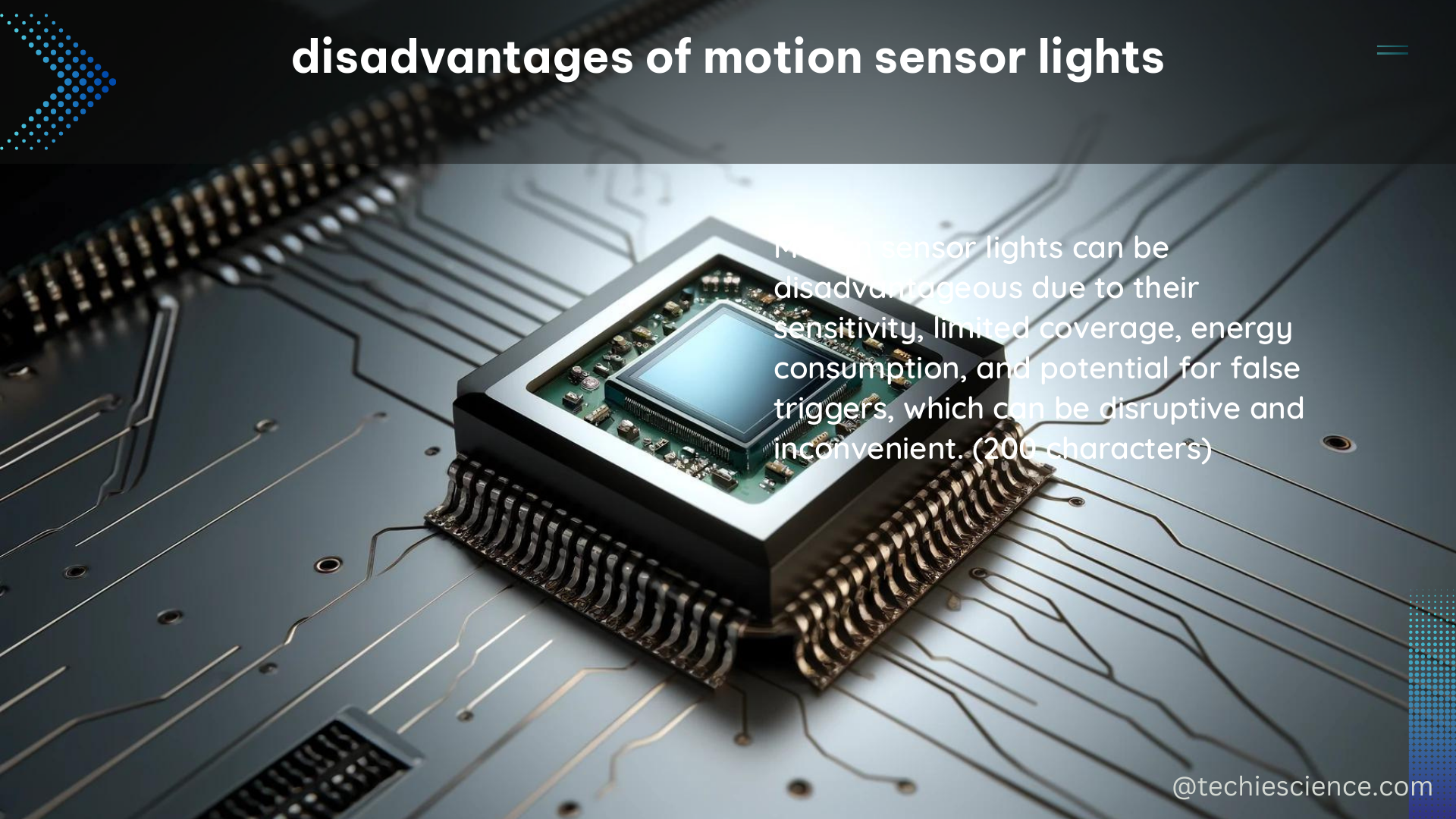Motion sensor lights have become increasingly popular in recent years, offering convenience, energy efficiency, and enhanced security. However, these lighting systems are not without their drawbacks. In this comprehensive guide, we will delve into the technical specifications and practical considerations surrounding the disadvantages of motion sensor lights.
Unreliable Triggering
One of the primary disadvantages of motion sensor lights is their unpredictable triggering. These lights can be activated by various environmental factors, such as wind, pets, or even passing vehicles, leading to unnecessary illumination. This unreliable behavior can be particularly frustrating for homeowners, as it can disrupt their daily routines and waste energy.
The technical specifications of this issue include the sensor’s sensitivity and detection range. Motion sensors typically use passive infrared (PIR) technology to detect movement, which can be influenced by factors like temperature, humidity, and the size and speed of the detected object. Manufacturers often provide adjustable sensitivity settings to mitigate this problem, but finding the right balance can be challenging.
Shortened Luminaire Lifespan

Another significant disadvantage of motion sensor lights is the frequent switching that occurs when the sensor detects movement. This repetitive on-and-off cycle can shorten the lifespan of the luminaires (light fixtures) used in the system.
The technical specifications related to this issue include the number of switching cycles the luminaires can withstand before failing. Typically, luminaires designed for motion-sensored lighting systems have a higher switching cycle rating, ranging from 50,000 to 100,000 cycles. However, in areas with high activity, the frequency of switching can exceed these ratings, leading to premature failure of the luminaires.
To mitigate this issue, it is essential to carefully consider the placement of the motion sensors and select luminaires with appropriate switching cycle ratings for the intended application. Additionally, using LED-based luminaires, which have a longer lifespan compared to traditional light sources, can help extend the overall system’s longevity.
Limited Detection Range
Motion sensors can also struggle with detecting objects or people moving at certain speeds or directions. This limitation can be particularly problematic in areas with large spaces or complex layouts, where the sensor may fail to register the presence of an individual.
The technical specifications related to the detection range include the sensor’s field of view, sensitivity, and maximum detection distance. Manufacturers typically provide these details, which can vary depending on the sensor type and model. For example, PIR sensors may have a detection range of 10-30 meters, while microwave sensors can have a range of up to 50 meters.
To ensure optimal performance, it is crucial to select motion sensors with a detection range suitable for the specific application and to position them strategically to cover the desired area effectively.
Data Collection Limitations
Motion sensor data can also be limited in its usefulness for physical activity research. Factors such as measurement error, population characteristics, reactivity to the device, and missing data can all impact the reliability and validity of the collected data.
The technical specifications related to this issue include the sensor’s sampling rate, accuracy, and data storage capabilities. Researchers must carefully consider these factors when selecting motion sensors for their studies, as the data collected may not accurately reflect the true physical activity levels of the participants.
To address these limitations, researchers may need to employ additional data collection methods, such as wearable activity trackers or direct observation, to corroborate the motion sensor data and obtain a more comprehensive understanding of physical activity patterns.
DIY Installation Challenges
For homeowners who opt to install motion sensor lights themselves, there are several disadvantages to consider:
-
Limited Expertise: Electrical work can be complex and potentially dangerous for those without the necessary skills and experience. Improper installation can lead to safety hazards or malfunctioning of the lighting system.
-
Inadequate Placement: Homeowners may struggle to determine the optimal placement of the motion sensors, leading to ineffective detection or unnecessary triggering.
-
Cost Considerations: While DIY installation can save on labor costs, the materials and tools required for the project can add up, potentially negating the cost savings.
To address these challenges, it is recommended to consult with a professional electrician or follow detailed installation guides to ensure the motion sensor lights are installed correctly and safely.
In conclusion, while motion sensor lights offer several benefits, it is essential to be aware of their disadvantages to make an informed decision and ensure the optimal performance of the lighting system. By understanding the technical specifications and practical considerations surrounding these disadvantages, homeowners and researchers can make more informed choices and mitigate the potential issues associated with motion sensor lights.
References:
1. The pros and cons of motion sensor lights | Cass County Electric. (2023-01-03). Retrieved from https://casscountyelectric.com/pros-and-cons-motion-sensor-lights
2. Advantages and Disadvantages of Motion-Sensored Lighting Systems. (n.d.). Retrieved from https://www.walkerbai.com/advantages-and-disadvantages-of-motion-sensored-lighting-systems/
3. Motion Sensor Use for Physical Activity Data: Methodological Considerations. (n.d.). Retrieved from https://www.ncbi.nlm.nih.gov/pmc/articles/PMC4487413/
4. What Are The Advantages & Disadvantages of Motion Sensor Security Lights. (2021-10-12). Retrieved from https://www.sansiled.com/blogs/learn/what-are-the-advantages-disadvantages-of-motion-sensor-security-lights
5. Quantifying Habitual Physical Activity and Sedentariness in Older People Using Wearable Devices: A Systematic Review. (2020-03-28). Retrieved from https://www.ncbi.nlm.nih.gov/pmc/articles/PMC7180487/

The lambdageeks.com Core SME Team is a group of experienced subject matter experts from diverse scientific and technical fields including Physics, Chemistry, Technology,Electronics & Electrical Engineering, Automotive, Mechanical Engineering. Our team collaborates to create high-quality, well-researched articles on a wide range of science and technology topics for the lambdageeks.com website.
All Our Senior SME are having more than 7 Years of experience in the respective fields . They are either Working Industry Professionals or assocaited With different Universities. Refer Our Authors Page to get to know About our Core SMEs.